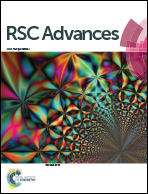Experimental design and multi-objective optimization of molecularly imprinted polymers for monosaccharides†
Abstract
The Taguchi method was used as an experimental design and optimization tool for the preparation of monosaccharide molecularly imprinted polymers (MIPs). Three factors, namely type of functional monomer, molar percentage of functional monomer, and functional monomer to template molar ratio, were included in the experimental design and based on the L16 (43) array, four levels of each factor were chosen. Imprinting factor, selectivity, and equilibration time were considered as quality characteristics of MIPs. For quantitative assessment of the quality of the prepared MIPs, the adsorption of template and competing substance on the prepared MIPs and non-imprinted polymers was monitored by the quartz crystal nanobalance (QCN) technique. The results revealed that regarding each quality characteristic, there are different optimal levels of the factors. The principal component analysis (PCA) technique was used to combine the quality characteristics in order to obtain a single characteristic for overall optimization of monosaccharide MIPs performance. So, PCA coupled with the Taguchi method was developed as an efficient procedure to optimize monosaccharide MIPs. The optimum values of molar percentage of functional monomer and the functional monomer to template molar ratio were found to be 30 and 4, respectively. We also found that acrylic acid (AAc) is a favourable functional monomer for preparing monosaccharide MIPs.


 Please wait while we load your content...
Please wait while we load your content...